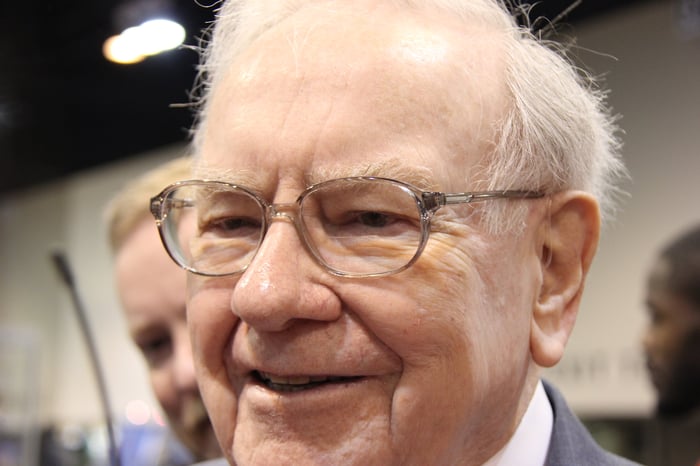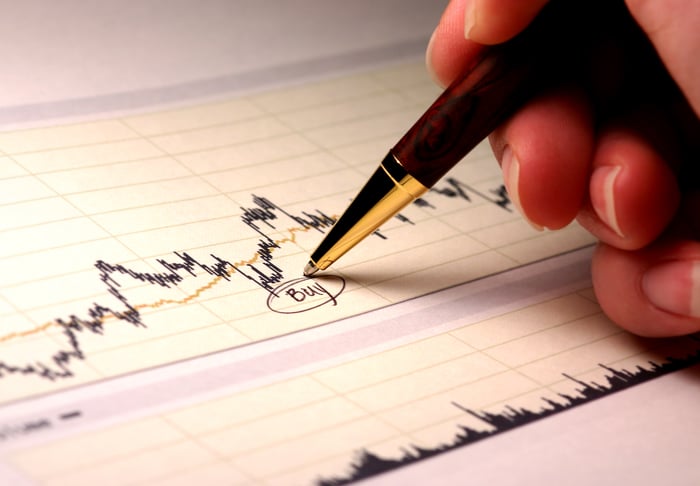There's little argument within the investment community that Berkshire Hathaway (BRK.A -0.28%) (BRK.B -0.68%) CEO Warren Buffett is an all-time great. For decades, the Oracle of Omaha has shown how powerful an ally time can be. Since becoming CEO in 1965, he's helped create more than $630 billion in value for shareholders (himself included) and overseen a greater than 3,600,000% return in his company's Class A shares (BRK.A).
Because of Buffett's highly successful track record, new and tenured investors wisely follow his lead and use his investment portfolio as inspiration when looking for new ideas. That's where Form 13F filings with the Securities and Exchange Commission have come in handy.

Berkshire Hathaway CEO Warren Buffett. Image source: The Motley Fool.
Investors closely monitor Berkshire Hathaway's 13Fs for investment ideas
A Form 13F is effectively a portfolio snapshot of what successful money managers held at the end of the most recent quarter. It allows everyday investors to see what the brightest minds on Wall Street have been buying and selling.
For instance, one glimpse of Berkshire Hathaway's portfolio today, compared to a year ago, shows how much conviction Warren Buffett has in energy stocks. At no point in this century have energy stocks comprised a double-digit percentage of Berkshire's investment portfolio -- until the June-ended quarter.
More specifically, Buffett and his team have piled into oil stocks Chevron (CVX 0.44%) and Occidental Petroleum (OXY -0.09%). The logic behind these sizable purchases is the expectation that the spot price for crude oil and natural gas will remain well above average. Reduced investment from energy companies during the pandemic, coupled with Russia's invasion of Ukraine, creates a scenario where boosting domestic and global supply is going to be difficult.
Both Chevron and Occidental are also integrated energy companies. This is a fancy way of saying that in addition to drilling and exploration, they operate transmission pipelines and/or downstream assets, such as refineries or chemical plants. If energy commodity prices were to decline, both companies have hedges in place.
Investors following Buffett's buying and selling activity via 13Fs can't miss the mammoth stake his company has built up in Apple (AAPL 1.27%), either. When the closing bell tolled on Nov. 4, Apple accounted for nearly 39% of Berkshire Hathaway's $328 billion of invested assets.
Apple has an exceptionally loyal customer base, the top-selling smartphone in the U.S. (by a mile), and its CEO, Tim Cook, is spearheading a multiyear transition that's seeing the company spread its wings as a service provider. It's a cash-flow monster with an equally impressive capital return program to boot, which is probably why it's such a hit with the Oracle of Omaha.

Image source: Getty Images.
Warren Buffett has invested $63.1 billion in this stock since July 2018
However, 13F filings aren't providing you with a complete picture of where Warren Buffett is putting his company's capital to work. To locate Buffett's favorite stock, you'll have to open up Berkshire Hathaway's quarterly earnings releases -- the latest of which hit the newswires on Saturday, Nov. 5.
Although Berkshire Hathaway's operating results list the five largest holdings by market value at the end of the latest quarter, it's the final page of the report, just before the exhibits and certifications, that offers investors a detailed look at Buffett's favorite stock (cue the irony): Berkshire Hathaway. It's the page that details the company's share buyback activity for the most recent quarter.
Prior to July 17, 2018, Warren Buffett and his right-hand man Charlie Munger were only able to repurchase shares of their company if it was valued at or below 120% of book value (i.e., no more than 20% above book value). For more than five years leading up to July 17, 2018, not a single share was repurchased because Berkshire Hathaway stock never fell to a book value of 120% or below. Then things changed.
July 17, 2018, marked the date where Berkshire's board passed new criteria to enable Buffett and Munger to execute buybacks. As long as Berkshire Hathaway has $30 billion in cash and U.S. Treasuries on its balance sheet, and Buffett and Munger agree that their company's stock is trading at a low intrinsic value, buybacks can continue without a cap.
Midway through 2022, Buffett and Munger had overseen the repurchase of $62.1 billion of their company's Class A and Class B stock since the new criteria went into effect. These buybacks continued during the third quarter, with Buffett and Munger green-lighting the repurchase of $1.04 billion in Class A stock. That brings the grand total of buybacks to roughly $63.1 billion since July 2018.
For a company like Buffett's that tends to steadily grow its net income over time, a reduced outstanding share count can have a positive impact on earnings per share. That can make Berkshire Hathaway more fundamentally attractive to investors.
Buying back stock is also a way Buffett can demonstrate to shareholders that he's willing to bet on himself and the long-term vision he's built at Berkshire Hathaway. Even though Berkshire Hathaway has endured down years with the Oracle of Omaha at the reins, Berkshire's stock has ultimately outperformed the benchmark S&P 500 by a factor of 120 since 1965.
Warren Buffett's favorite stock to buy unquestionably remains Berkshire Hathaway, and he continues to send signals to the investment community that it's still a bargain.





